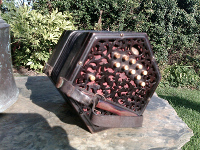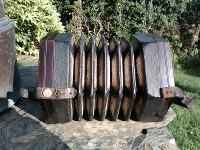-
Posts
1,286 -
Joined
-
Last visited
Everything posted by Roger Hare
-
Brilliant! Do you have the reverse side image with the instructions? I can see a few similar (post)cards in the internet - I wonder who George Piper was? There's no real info on the site I found (presumably the one you looked at). Roger
-
I'm a novice player with a 20-button C/G Lachenal Anglo which I acquired a few weeks ago. I am having a complete blast with this instrument - I wish I'd bought a concertina years and years ago! I'm so enthusiastic (my sailing buddies say too enthusiastic!) that I'm already considering acquiring an instrument with a third row of 'accidentals'. I'm put off a little by the prices of restored instruments, and found this 'entry-level' instrument on the internet: http://www.irishmusik.com/the-wren-concertina/ Does anyone have any experience with this machine? Any advice on what to look out for or beware of? Any advice would be most gratefully received. Thank you Roger Hare
-

Concertina Trade-In Regret!
Roger Hare replied to HansiRowe's topic in General Concertina Discussion
I came across this concertina-related quote the other day: "Anybody who has...heard certain kinds of performance on the concertina, will admit that even suicide has its brighter aspects.", Stephen Leacock, 1912. It's a bit barbed, and of course, has no basis in fact. I reackon Leacock must have been feeling a bit liverish that day. Roger Hare- 4 replies
-
- Concertina value
- trade-in
-
(and 1 more)
Tagged with:
-

Mrs. Boyce Threw A Concertina At His ‘Ed….
Roger Hare replied to HansiRowe's topic in General Concertina Discussion
"Full article is here . It was written by c.net member Dan Worrall and later became part of his excellent two-volume book The Anglo-German Concertina: A Social History. More info about the book and Dan's other very valuable projects can be found on his web site: http://www.angloconcertina.org." Amazing stuff - thank you very much. I just ordered the book(s) - looks too good to miss! Roger- 4 replies
-
- Concertinas
- working class
-
(and 2 more)
Tagged with:
-

Mrs. Boyce Threw A Concertina At His ‘Ed….
Roger Hare replied to HansiRowe's topic in General Concertina Discussion
"..At any hour of the night a fool in love with a concertina may disturb the whole neighborhood with noises he pleases to think music..." Well now, I've been looking for concertina quotes for the last couple of days - found four so far - you have just increased the total to eight - all four of them crackers! Thank you very much! Must look at the full article... Roger Hare- 4 replies
-
- Concertinas
- working class
-
(and 2 more)
Tagged with:
-

1949 'the Last Concertina Repairer' ?
Roger Hare replied to Warren Fahey's topic in General Concertina Discussion
Yes, I found a few myself when I did a search later. When I get time, I will follow this one up. Roger -

1949 'the Last Concertina Repairer' ?
Roger Hare replied to Warren Fahey's topic in General Concertina Discussion
>might I suggest you start a thread specifically for postcards & concertinas. It's a thought, innit? Include other concertina-related stuff, and call it 'Concertinabilia'? When I actually have some concertina-related artefact(s), I'll revisit this one... Roger -

1949 'the Last Concertina Repairer' ?
Roger Hare replied to Warren Fahey's topic in General Concertina Discussion
>I'm presuming that you've checked out eBay? At the time I posted, I hadn't, but I made it my next job, and I see that there are indeed concertina cards out there. I usually look for art shipping cards, now I have another search to do - life's never easy is it... Thanks for your input. Roger -

1949 'the Last Concertina Repairer' ?
Roger Hare replied to Warren Fahey's topic in General Concertina Discussion
Hm! I am a postcard collector as well as a novice concertina player (sad, ain't it?). Have you come across any postcards featuring concertinas? I can feel another collecting theme coming on... Thanks. Roger Hare -
Does anyone out there know where I can find 'sheet music' for this Kipling poem set to music by Peter Bellamy? Is the tune used by Bellamy the same as the Edward German one? I've had a look but can't find a definitive answer on the internet. I can probably work the tune out by repeated listening to PB (always a pleasure!), but I'd like to hone my rudimentary musical skills by working with the printed score if I can. Thank you. Roger Hare
-

New Player, New Member, Old(Ish) Concertina...
Roger Hare replied to Roger Hare's topic in General Concertina Discussion
I won't try and respond individually to all the helpful replies I have received to my queries, but a collective thank you to all those who replied. In particular, it's encouraging that a musical illiterate like me can suppose that there *may* be different layouts, and that it *is* possble to play tunes in key X on an instrument in key Y, and then have that supposition confirmed! It's all very encouraging. This means that I can 'wing it' with a clear conscience! To surmise, without any evidence that maybe, just maybe, different instruments can have different layouts, and then have that confirmed, is similarly encouraging (thank you very much for the diagram explaining the different possible layouts on the 20 button instrument - very useful). The information about dating is also useful. The man who supplied my instrument says that his dating was approximate, and that he wouldn't be surprised if the instrument was significantly earlier. The possible earlier date would also tie in with the suggestion in these posts that the button/note layout on my instrument is similar to the original (and presumably earlier) German manufactured 'Anglo' style instruments. Thanks too for the suggestions relating to the ABC system and the relevant web sites - I have already looked at, and transposed a couple of tunes so that I can (attempt to) play them. Fascinating stuff! Once again, thank you all very much! Roger. -

New Player, New Member, Old(Ish) Concertina...
Roger Hare replied to Roger Hare's topic in General Concertina Discussion
>Mick Bramich's ABC book has what the F# shown backwards from every concertina I've known - either a typo >or his concertina is different from all of ours. I did wonder if it was a typo... >You are interpreting your instrument correctly and in fact it is a conventional layout. Thank you for that. It's encouraging that a musical illiterate like wot I am can spot a problem and come up with a more or less correct solution... Roger Hare -

Is 'concertina' So Difficult To Say?
Roger Hare replied to SteveS's topic in General Concertina Discussion
>Nobody has yet put forward a liking for 'tina. Or is it 'teena? I was affectionally calling my instrument 'Tina before I even bought the damn thing. Now, 9 days after acquiring it, I'm already referring to it as the 'infernal machine'... Apropos mis-pronunciations (as opposed to perfectly sound regional/dialect variants), I collect these, sometimes from the august air waves of BBC Radio 4, more frequently from the slightly less august airwaves of BBC Radio 5 Live and BBC Radio 4 Extra. Here are a couple of my farouvites: Narcistic - Narcissistic Apolyptic - Apocalyptic Cohlin - Colin Rohger (sorry! Roger) Hare -

New Player, New Member, Old(Ish) Concertina...
Roger Hare replied to Roger Hare's topic in General Concertina Discussion
I'm not sure of the etiquette on these fora yet, so rather than start a new thread, I'll tag this on to the tail-end of my first post - after all, it's a novices question, and it (sort of) follows on from one of my earlier questions. Here goes: The layout of the buttons on my 20 button C/G Anglo seems to differ slightly, both from the diagram of a 20 button C/G Anglo layout at the Digital Concertina Archive (DCA), and from the diagram in Mick Bramich's 'Absolute Beginners' Concertina' (ABC). I know that some layouts were different, but as I'm a complete novice, a little advice wouldn't come amiss... I *think* that the G-row on my instrument (going left-to-right, 5-4-3-2-1-|-1-2-3-4-5, push-pull) is: G-D-D-F#-G-A-B-C-D-E-|G-F#-B-A-D-C-G-E-B-F# which differs subtly from both the DCA layout on the internet, and from that in the ABC book (button 5 is different for both left and right sides). This isn't a problem, in fact, this would mean that the notes I have in the key of G map precisely onto the equivalent notes in the key of C (ie: on the C-row), so that (in crude terms) anything I can play in C, I can play in G just by shifting rows, and vice-versa. This is my interpretation of what I have on my instrument. Is this feasible? likely? totally impossible? a dream come true? Thank you. Roger Hare -
OK, I've tried to attach three pictures to this reply - seems to have worked. These pictures were taken about three weeks ago before restoration by Nigel Sture down here in Devon. Hope they are of interest. Roger
-
>The figures I use for Lachenal anglos are somewhere on this site... Thank you for the serial numbers and projected dates. A lot more information than I had before! >can you post a photo of yours, would love to see it? I have sent pictures before restoration to your private email. It is my intention to use a picture of the infernal machine as my 'signature' picture when I get my act together... Roger
-
>My Lachenal Anglo with the serial number 87119 has just been dated to circa 1885 I've just acquired my first concertina - a Lachenal 20 button C/G Anglo. It has the serial number 74693 and I'm told it is dated to 1895. Looking at it 'logically', assuming that the serial numbers correlate (roughly) with date, there's an inconsistency here? So my question is, were these things numbered sequentially, or was there a different sequence of numbers for different models? Looking at the pictures, my instrument is similar to yours but not *exactly* the same - the 'window' through which the serial number is visible is a different shape on mine, so it's a different model? I can't see any information about Lachenal serial numbers on the Digital Concertina Archive which answers this question. I'm trying to find out as much about mine as I can. Any thoughts? Thanks. Roger Hare.
-

New Player, New Member, Old(Ish) Concertina...
Roger Hare replied to Roger Hare's topic in General Concertina Discussion
>If you worked it out yourself from memory then maybe you came up with a version in C. What is the last note in your melody? This >is usually, but not always, the tonic or key note for the tune. In the case of the German Musicianer, the last note is the key note. Correct! The last note in 'my version' is C - and of course, if I play it in G (ie: on the G row), the last note is G, so it all starts to hang together... Thank you for the information about ABC notation, I have tried it out and it seems to work (well, it would, wouldn't it). This is going to be very valuable as I try to convert from one key to t'other (for singing). >...maybe you came up with a version in C... Yes. I now see that there is often more than one version of a tune - I just looked at 'She Moved Through the Fair' and there are several versions of that one too. I'm feeling better already! Thank you very much for all that useful information - should keep me quiet for a while! >You mean "Pilgrim's Way"? Yes, I do. I've recently been browsing "Pilgrim's Progress" by John Bunyan, hence the mental slip. And, Yup! I just looked at your reference, and that's the one. I hadn't realised it was one of the Kipling settings. Thanks again. Roger. -

New Player, New Member, Old(Ish) Concertina...
Roger Hare replied to Roger Hare's topic in General Concertina Discussion
>My question to you is, do you really get to mess about in Brixham Trawlers?!? Yes. I am a 'volunteer' and shareholder in the newly restored Brixham sailing trawler 'Pilgrim' (http://pilgrimofbrixham.co.uk/). Soon to be a director of the company I hope. Been sailing these boats for most of the last (almost) 20 years, and this year I have managed to sail on the other three big local trawlers 'Leader', 'Provident' and 'Vigilance' as well as sailing on 'Pilgrim'. A concertina is a handy thing to have on these boats, particularly at French trad boat festivals! So that this reply isn't *entirely* off-topic, one of the tunes I hope to pick up in the near future is 'A Pilgrim's Progress'. I know that Peter Bellamy sang this one one of his LPs but I haven't tracked that one down yet. I'm also actively trying to learn 'Le 31 du mois d'Aout', a fine old French song beloved of French yachtsmen because it's mildly offensive to the 'Rosbifs'! Roger -
Hi, I'm a new player, and a new member, so my first post is full of questions! After many years fannying about, I finally took the plunge and bought a concertina when I discovered that one of my sailing buddies was a novice player too. I've acquired Lachenal 20 button C/G Anglo concertina no 74693 (hence the user name!), vintage 1895. This is a happy co-incidence - the restored sailing trawler I muck about on was also constructed in 1895! However, I have a couple of questions: 1) The button layout on my instrument is the same as that shown in the Anglo fingering chart on the Digital Concertina Archive. However, this differs slightly from that assumed in my tutor - I think that the F and F# on the right hand side button 5 in the G row are transposed. The tutor states that "This [the layout] can vary from make to make.". Fair enough, but how common are deviations from the 'standard' layout, and does it matter? 2) My knowledge of musical theory is limited, but I know that the key of C consists of 'natural' notes, and that the key of G contains only one 'accidental' (F#). But, three days after acquiring the instrument, I have worked out a recognisable version of one of my favourite tunes 'The German Musicianer'. But this tune is in D (two sharps) according to the score I have found on the internet. How is it possible to play a tune in a key for which one does not have all the notes? I have seen a comment on a manufacturer's website which effectively states that (I paraphrase...) 'we only manufacture C/G concertinas which cover the range of all traditional music and is able to be played in the less common keys as well', so clearly it's possible, but how does this work? Two solutions occur to me: (i) by a happy co-incidence, the tune does not contain either of the accidentals which occur in the key of D; (ii) I am cunningly and unconsciously 'modifying' the tune as I learn it to replace any accidentals with naturals, the result being 'good enough' for folk music. I am not entirely convinced by either of these 'explanations'. So, I ask again, how does this work? Help! Thank you. Roger Hare.




